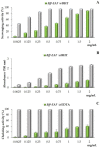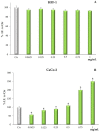Chemical Profile, Antioxidant and Cytotoxic Activity of a Phenolic-Rich Fraction from the Leaves of Brassica fruticulosa subsp. fruticulosa (Brassicaceae) Growing Wild in Sicily (Italy)
- PMID: 36903527
- PMCID: PMC10005747
- DOI: 10.3390/molecules28052281
Chemical Profile, Antioxidant and Cytotoxic Activity of a Phenolic-Rich Fraction from the Leaves of Brassica fruticulosa subsp. fruticulosa (Brassicaceae) Growing Wild in Sicily (Italy)
Abstract
Recently, our research team has started a study on Brassica fruticulosa subsp. fruticulosa, an edible plant traditionally used to treat various ailments, little investigated to date. Good in vitro antioxidant properties were highlighted for the leaf hydroalcoholic extract, with the secondary higher than the primary ones. In continuation of the ongoing research, this work was designed to elucidate the antioxidant properties of the phenolic compounds contained in the extract. For this purpose, a phenolic-rich ethyl acetate fraction (Bff-EAF) was obtained from the crude extract by liquid-liquid extraction. The phenolic composition was characterized by HPLC-PDA/ESI-MS analysis and the antioxidant potential was investigated by different in vitro methods. Furthermore, the cytotoxic properties were evaluated by MTT, LDH and ROS determinations on human colorectal epithelial adenocarcinoma cells (CaCo-2) and human normal fibroblasts (HFF-1). Twenty phenolic compounds (flavonoid and phenolic acid derivatives) were identified in Bff-EAF. The fraction exhibited good radical scavenging activity in the DPPH test (IC50 = 0.81 ± 0.02 mg/mL), and moderate reducing power (ASE/mL = 13.10 ± 0.94) and chelating properties (IC50 = 2.27 ± 0.18 mg/mL), contrary to what previously observed for the crude extract. Bff-EAF reduced in a dose-dependent manner CaCo-2 cell proliferation after 72 h of treatment. This effect was accompanied by the destabilization of the cellular redox state due to the antioxidant and pro-oxidant activities displayed by the fraction at lower and higher concentrations. No cytotoxic effect was observed on HFF-1 fibroblasts, used as control cell line.
Keywords: Mediterranean cabbage; Sicilian vascular flora; biological activities; edible wild plants; polyphenols; traditional medicine.
Conflict of interest statement
The authors declare no conflict of interest.
Figures





Similar articles
-
Phenolic and Volatile Composition and Antioxidant Properties of the Leaf Extract of Brassica fruticulosa subsp. fruticulosa (Brassicaceae) Growing Wild in Sicily (Italy).Molecules. 2022 Apr 26;27(9):2768. doi: 10.3390/molecules27092768. Molecules. 2022. PMID: 35566126 Free PMC article.
-
Chemical Characterization and Biological Activities of Phenolic-Rich Fraction from Cauline Leaves of Isatis tinctoria L. (Brassicaceae) Growing in Sicily, Italy.Chem Biodivers. 2017 Aug;14(8). doi: 10.1002/cbdv.201700073. Epub 2017 Jul 29. Chem Biodivers. 2017. PMID: 28622440
-
Contribution of Phenolic Compounds to the Antioxidant Activity of Leaf and Flower Extracts of Sinapis pubescens L. subsp. pubescens (Brassicaceae).Chem Biodivers. 2024 May;21(5):e202400272. doi: 10.1002/cbdv.202400272. Epub 2024 Apr 17. Chem Biodivers. 2024. PMID: 38489001
-
Brassica incana Ten. (Brassicaceae): Phenolic Constituents, Antioxidant and Cytotoxic Properties of the Leaf and Flowering Top Extracts.Molecules. 2020 Mar 24;25(6):1461. doi: 10.3390/molecules25061461. Molecules. 2020. PMID: 32213889 Free PMC article.
-
Phytochemical Constituents, Antioxidant Activity, and Toxicity Assessment of the Aerial Part Extracts from the Infraspecific Taxa of Matthiola fruticulosa (Brassicaceae) Endemic to Sicily.Molecules. 2021 Jul 6;26(14):4114. doi: 10.3390/molecules26144114. Molecules. 2021. PMID: 34299388 Free PMC article.
Cited by
-
Chemical Characterization, Free Radical Scavenging, and Cellular Antioxidant Properties of the Egadi Island Endemic Brassica macrocarpa Guss Leaf Extract.Biomolecules. 2024 May 29;14(6):636. doi: 10.3390/biom14060636. Biomolecules. 2024. PMID: 38927041 Free PMC article.
-
HPLC-HESI-MS/MS Analysis of Phenolic Compounds from Cynoglossum tubiflorus Leaf Extracts: An Assessment of Their Cytotoxic, Antioxidant, and Antibacterial Properties.Plants (Basel). 2024 Mar 21;13(6):909. doi: 10.3390/plants13060909. Plants (Basel). 2024. PMID: 38592935 Free PMC article.
References
-
- Rahman M.M., Rahaman M.S., Islam M.R., Rahman F., Mithi F.M., Alqahtani T., Almikhlafi M.A., Alghamdi S.Q., Alruwaili A.S., Hossain M.S., et al. Role of phenolic compounds in human disease: Current knowledge and future prospects. Molecules. 2022;27:233. doi: 10.3390/molecules27010233. - DOI - PMC - PubMed
-
- Jahangir M., Kim H.K., Choi Y.H., Verpoorte R. Health-affecting compounds in Brassicaceae. Compr. Rev. Food Sci. Food Saf. 2009;8:31–43. doi: 10.1111/j.1541-4337.2008.00065.x. - DOI
-
- Doniec J., Florkiewicz A., Socha R., Filipiak-Florkiewicz A. Polyphenolic acid content in Brassica vegetables during hydrothermal treatment with salt addition. J. Food Process. Preserv. 2022;46:e16219. doi: 10.1111/jfpp.16219. - DOI
-
- Gonçalves E.M., Alegria C., Abreu M. Benefits of Brassica Nutraceutical Compounds on Human Health. In: Lang M., editor. Brassicaceae—Characterization, Functional Genomics and Health Benefits. Nova Biomedical; New York, NY, USA: 2013. pp. 19–65.
MeSH terms
Substances
LinkOut - more resources
Full Text Sources
Medical

